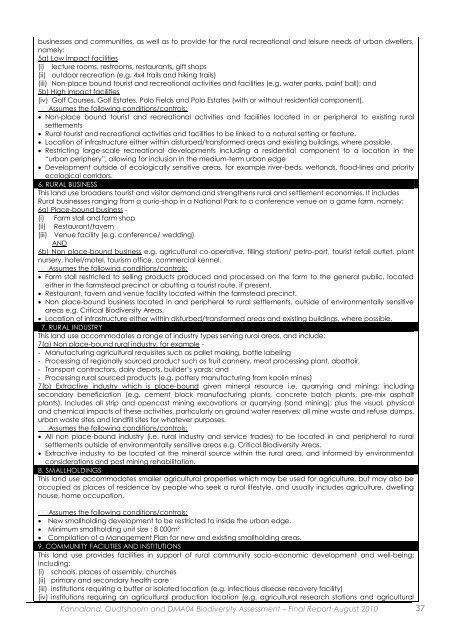Little Karoo Biodiversity Assessment - Biodiversity GIS - SANBI
Little Karoo Biodiversity Assessment - Biodiversity GIS - SANBI
Little Karoo Biodiversity Assessment - Biodiversity GIS - SANBI
You also want an ePaper? Increase the reach of your titles
YUMPU automatically turns print PDFs into web optimized ePapers that Google loves.
usinesses and communities, as well as to provide for the rural recreational and leisure needs of urban dwellers,namely:5a) Low impact facilities(i) lecture rooms, restrooms, restaurants, gift shops(ii) outdoor recreation (e.g. 4x4 trails and hiking trails)(iii) Non-place bound tourist and recreational activities and facilities (e.g. water parks, paint ball); and5b) High impact facilities(iv) Golf Courses, Golf Estates, Polo Fields and Polo Estates (with or without residential component).Assumes the following conditions/controls: Non-place bound tourist and recreational activities and facilities located in or peripheral to existing ruralsettlements Rural tourist and recreational activities and facilities to be linked to a natural setting or feature. Location of infrastructure either within disturbed/transformed areas and existing buildings, where possible. Restricting large-scale recreational developments including a residential component to a location in the“urban periphery”, allowing for inclusion in the medium-term urban edge Development outside of ecologically sensitive areas, for example river-beds, wetlands, flood-lines and priorityecological corridors.6. RURAL BUSINESSThis land use broadens tourist and visitor demand and strengthens rural and settlement economies. It includesRural businesses ranging from a curio-shop in a National Park to a conference venue on a game farm, namely:6a) Place-bound business -(i) Farm stall and farm shop(ii) Restaurant/tavern(iii) Venue facility (e.g. conference/ wedding)AND6b) Non place-bound business e.g. agricultural co-operative, filling station/ petro-port, tourist retail outlet, plantnursery, hotel/motel, tourism office, commercial kennel.Assumes the following conditions/controls: Farm stall restricted to selling products produced and processed on the farm to the general public, locatedeither in the farmstead precinct or abutting a tourist route, if present. Restaurant, tavern and venue facility located within the farmstead precinct. Non place-bound business located in and peripheral to rural settlements, outside of environmentally sensitiveareas e.g. Critical <strong>Biodiversity</strong> Areas. Location of infrastructure either within disturbed/transformed areas and existing buildings, where possible.7. RURAL INDUSTRYThis land use accommodates a range of industry types serving rural areas, and include:7(a) Non place-bound rural industry, for example -- Manufacturing agricultural requisites such as pallet making, bottle labeling- Processing of regionally sourced product such as fruit cannery, meat processing plant, abattoir,- Transport contractors, dairy depots, builder‟s yards; and- Processing rural sourced products (e.g. pottery manufacturing from kaolin mines)7(b) Extractive industry which is place-bound given mineral resource i.e. quarrying and mining; includingsecondary beneficiation (e.g. cement block manufacturing plants, concrete batch plants, pre-mix asphaltplants). Includes all strip and opencast mining excavations or quarrying (sand mining); plus the visual, physicaland chemical impacts of these activities, particularly on ground water reserves; all mine waste and refuse dumps,urban waste sites and landfill sites for whatever purposes.Assumes the following conditions/controls: All non place-bound industry (i.e. rural industry and service trades) to be located in and peripheral to ruralsettlements outside of environmentally sensitive areas e.g. Critical <strong>Biodiversity</strong> Areas. Extractive industry to be located at the mineral source within the rural area, and informed by environmentalconsiderations and post mining rehabilitation.8. SMALLHOLDINGSThis land use accommodates smaller agricultural properties which may be used for agriculture, but may also beoccupied as places of residence by people who seek a rural lifestyle, and usually includes agriculture, dwellinghouse, home occupation.Assumes the following conditions/controls: New smallholding development to be restricted to inside the urban edge. Minimum smallholding unit size : 8 000m² Compilation of a Management Plan for new and existing smallholding areas.9. COMMUNITY FACILITIES AND INSTITUTIONSThis land use provides facilities in support of rural community socio-economic development and well-being;including:(i) schools, places of assembly, churches(ii) primary and secondary health care(iii) institutions requiring a buffer or isolated location (e.g. infectious disease recovery facility)(iv) institutions requiring an agricultural production location (e.g. agricultural research stations and agriculturalKannaland, Oudtshoorn and DMA04 <strong>Biodiversity</strong> <strong>Assessment</strong> – Final Report August 2010 37
















